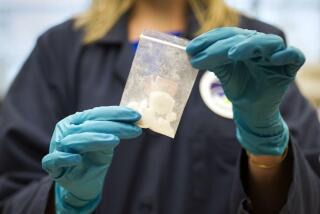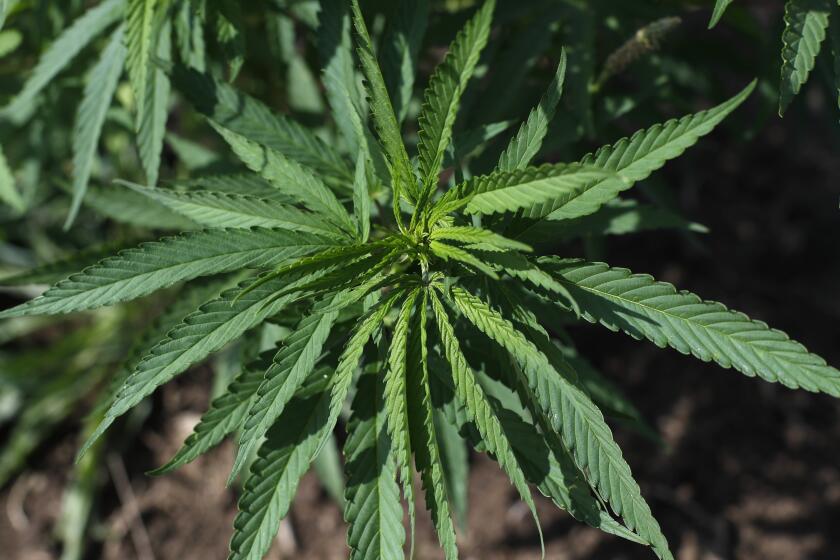In the Fight Against a Silent Epidemic : Addiction: Donât rest easy because your children arenât using heroin or crack. They could be playing with a fire thatâs <i> not</i> illegal and even more insidious: inhalants.
Jennifer (J.J.) Jones of Palm Beach Gardens, Fla., knew enough to stay away from drugs. Frank discussions with her mother, Grace, had made the 15-year-old high school honor student well aware of the minefield of cocaine, crack and heroin use.
But the apprehensions of mother and daughter didnât extend to the Freon that a friend of J.J.âs had drained from an air conditioner one day and showed her how to sniff.
Police theorize that J.J. took a large hit of the chemical from a plastic bag and was knocked unconscious. Unable to remove the bag from her face, she continued to breathe in Freon until she died.
âMy daughter learned how to do it from a friend on Wednesday and she tried it for the first time on a Sunday and she died,â says Jones. âI couldnât warn her about something I knew nothing about.â
In the culture of drug use, sniffing--or huffing--has traditionally been regarded as kidâs stuff, a stunt pulled by adolescents and preteens using felt-tip pens and tubes of Elmerâs. But drug counselors and treatment professionals say a different scenario is emerging nationwide--one of ignorant teen-agers and parents, and a variety of readily available toxic substances.
Cutting across race and socioeconomic lines, huffing has evolved into what the National Inhalant Prevention Coalition has dubbed âthe cocaine of the â90s.â
More than 1,000 people nationwide die annually from sniffing substances found âright under the kitchen sink,â according to another anti-inhalant group, the Colorado-based International Institute on Inhalant Abuse.
No longer a practice relegated to Third World slums, inhalants now rank as the third most used âdrugâ after alcohol and marijuana among students in the United States grades 8 through 12. National surveys have found that 20% of all eighth-graders have huffed toxic substances, with inhalants also figuring prominently in the drug use of older teens.
âItâs becoming more mainstream,â says Harvey Weiss, chairman of the National Inhalant Prevention Coalition in Austin, Tex. âKids say, âI can get this. Itâs cheap and easy to get, and Iâm not going to get busted for it.â â
According to the coalition, more than 1,000 household, office and school products can be sniffed to get high, with gasoline, glue, aerosol, butane and solvents such as toluene being the most popular. The more knowledgeable huffers seek out containers labeled with a skull and crossbones, which promises a bigger and better high.
Drug-treatment professionals tell stories of third-graders sniffing âwhite-outâ dabbed under their fingernails. Canisters of air fresheners, bottles of nail-polish remover and bags of moth balls all carry the potential for a cheap kick, without the stigma of being illegal or the threat of being physically addictive.
Yet, these substances can be far more dangerous and damaging than heroin, cocaine or marijuana, says Dr. Neil Rosenberg, founder of the Colorado institute. Long-term and permanent neurological damage--akin to the type that produces multiple sclerosis--can result from huffing, he says.
A 1986 study of 20 chronic toluene sniffers found that nearly two-thirds suffered damage to their nervous system. (Toluene is generally found in lacquers and spray paints.)
For pregnant women, use of inhalants has been linked with low birth weights and abnormally small heads in newborns, which is associated with mental retardation.
Because the fumes of sniffed substances pass directly to the brain, death can result from just a single, overwhelming huff. Users can suffocate when they inhale chemicals that coat their lungs, thereby preventing oxygen from entering the bloodstream.
Huffing also has a high death rate among first-time users--30%, according to a British study. Some users suffered heart failure triggered by adrenaline surges while under the influence of inhalants.
Indeed, huffing gives pause for disbelief, says Dr. Charles Sharp of the National Institute on Drug Abuse, just considering the effectiveness of delivery (âfaster than an IVâ) and the type of chemicals being huffed.
âThis material, itâs what people (use) to commit suicide on,â he says. âYou donât know when you will get the dose that will kill you.â
Ignorance of inhalants exists on all fronts, say experts--from users to physicians to law enforcement--and contributes to a wide-scale underreporting of usage. Few physicians or police are attuned to looking for the effects of inhalant abuse, even when faced with teen deaths resulting from automobile accidents or involving other drugs.
âIf you die from butane, no one will know,â says Sharp. âNo one will detect it unless someone reports (the deceased) as a butane user.â
Echoes Doug Bohm of the institute: âKids end up dead and it gets labeled a suicide (rather than an accidental death). Thereâs a real lack of awareness on the part of law enforcement and the medical profession.â
Parents, too, are often in the dark and may not give a second thought to children with paint stains on their mouths and hands, or red or runny eyes and noses. Other symptoms of inhalant use include behaving dazed or drunk.
Because standard drug tests do not detect the presence of many inhalants, users can appear to be clean. âYou donât expect your kid to be inhaling Glade,â says Bohm.
Some anti-inhalant activists have called for legislation to battle the silent epidemic. In January, Pennsylvania state Sen. David Heckler reintroduced a bill into the state Legislature that would ban the sale of butane to those under 18--the first such bill aimed at limiting access to dangerous inhalants.
But the chemical industry, while voicing concern over the rise of huffing, opposes such legislation, saying âitâs not fairâ to the products they manufacture.
âThatâs curtailing the use for people who do use the products correctly,â says Evelyne McFeaters, a program manager with the Chemical Specialities Manufacturers Assn., an organization of 440 companies involved in the manufacture, distribution and sale of chemical products.
Given the gamut of available, sniffable products, inhalant abuse experts are preferring to concentrate their efforts on education.
Since her daughterâs death, for example, Grace Jones has become an activist, lecturing at schools and working with parents and doctors and nurses to promote awareness of inhalant abuse.
âIâll be real honest with you, I would have much rather if (J.J.) had gotten into drugs like marijuana because that wouldnât have killed her,â she says from her Florida home. âInhalants are like Russian roulette. You put the bullet in and ask yourself, âDo I feel lucky today?â â
More to Read
Sign up for Essential California
The most important California stories and recommendations in your inbox every morning.
You may occasionally receive promotional content from the Los Angeles Times.










